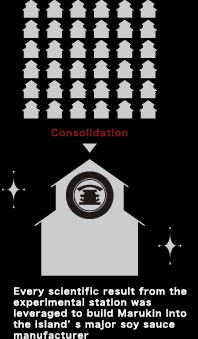HISTORY
It is generally believed that the origins of Shodoshima soy sauce date back to the closing years of the 16th century. Salt production had flourished on the island since ancient times and gradually soy sauce began to be produced using the island’s high quality salt as one of the main ingredients. At that time, Shodoshima served as a strategic way station for maritime transport. Thus it was easy to obtain the raw materials used to make soy sauce and to ship the finished soy sauce throughout the Seto Inland Sea area. Shodoshima’s warm climate and low rainfall proved to be well-suited to soy sauce production and were one of the key factors propelling the industry’s growth on the island.
-
1. In the beginning
Around the time soy sauce production was starting to take root, stone was being quarried on Shodoshima for the construction of Osaka Castle. It was usual for the quarry workers to season their food with the clear liquid that formed on top of kinzanji miso which was introduced to Yuasa Town in Kii Province (present-day Wakayama prefecture) from China in the 13th century. This much-prized seasoning, the predecessor of soy sauce, roused the interest of our ancestors who travelled to Yuasa to learn how to make it.
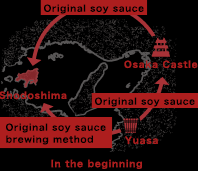
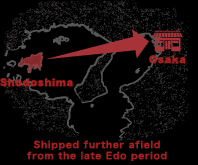
-
2. Reasons behind the growth of Shodoshima’s soy sauce industry
(1) Major salt producing area
Shodoshima had a flourishing salt industry from ancient times and salt from the island was highly acclaimed for its “pure whiteness and superior taste”. By the end of the 17th century Shodoshima had the second largest output after Ako City in Hyogo Prefecture. However, with the spread of salt production across the Seto Inland Sea area in the latter half of the Edo period, the industry suffered due to overproduction, leading to a shift to soy sauce production using the island’s salt as one of the main ingredients.
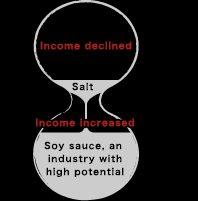
(2) Strategic location and flourishing shipping industry
Shodoshima’s soy sauce industry prospered due to the island’s proximity to the trading port of Sakai and to Osaka, known as the “nation’s kitchen”, as well as to the flourishing shipping industry that enabled it to easily obtain soybeans and wheat and to ship the finished soy sauce to the surrounding areas. Marine transportation enjoyed an overwhelming advantage over land transportation at that time.
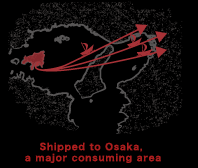
(3) Thriving trade with Kyushu
Shodoshima had long engaged in trade with Kyushu, shipping somen noodles and salt to Kyushu and bringing back soybeans and wheat, the essential ingredients for soy sauce production.
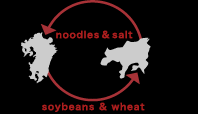
(4) Limited farmland area
Due to the mountainous terrain and limited area of cultivable land, it was impossible for Shodoshima to be self-sufficient in rice. Daily life was sustained by selling salt, soy sauce and somen noodles in the surrounding region and using the money thus obtained to purchase rice, wheat and other foods.
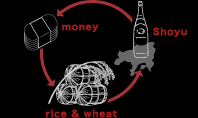
(5) Open-minded and enterprising nature of the islanders
With their long history of engagement in domestic and foreign trade, it was only natural that the inhabitants of Shodoshima developed an outward-looking, enterprising spirit.

(6) Direct government by the shogunate
For 260 years during the Edo period, most of Shodoshima was under the direct control of the shogunate. The shogunate’s rule was relatively benign, with no domainal patronisation or protection, no taxes for certifying business rights and no special protection or restrictions. Thus it was easy for the soy sauce industry to take root and thrive.
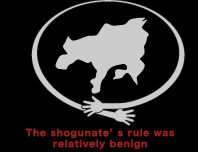
(7) Climate
Shodoshima’s hot, dry climate and clear air were well-suited to soy sauce production.
The various conditions described above helped Shodoshima develop into a leading soy sauce producing area.

-
3. Shodoshima soy sauce spreads beyond the island
Initially, soy sauce was produced mainly for consumption on the island, but in the late 18th century it began to be shipped to Kyoto, Osaka and Kobe. In the late 1870s to early 1880s there were about 400 soy sauce brewers on Shodoshima. This led to the establishment of Eikyusha, an association that exercised authority over the soy sauce manufacturers. Shipping of inferior products was curbed to guarantee the quality of the island’s soy sauce. Then, in 1901, the Shodoshima Shoyu Manufacturers Association (the present-day Shodoshima Shoyu Association) was formed centred on the Eikyusha members. The members worked together to select the best ingredients, improve the brewing method and, in particular, streamline dealings with wholesale stores, thus laying the ground for Shodoshima’s soy sauce industry.
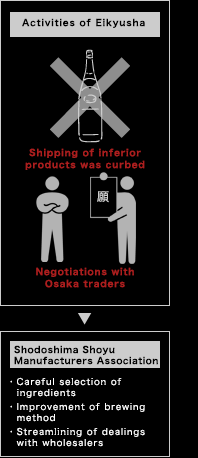
-
4. Shodoshima as a major producing area
To enhance the quality of soy sauce, the Kagawa Prefectural Soy Sauce Experimental Station (the present-day Fermentation & Food Research Institute) was established. Many of the small, family-run soy sauce breweries that existed at that time were consolidated to form Marukin Shoyu (the present-day Morita Co., Ltd., Shodoshima Soy Sauce Brewery). By exploiting to the full the know-how and expertise of the experimental station, Marukin grew to be a major soy sauce manufacturer, ranking among leading companies in the Kanto region. And Marukin continues to grow today, incorporating the best of the new and the old.
